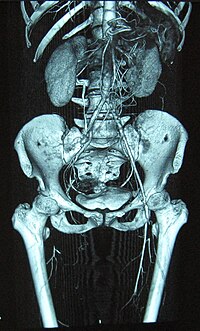
Photo from wikipedia
Si-Miao-Yong-An-Tang (SMYAT) is a classic prescription for the treatment of thromboangiitis obliterans (TAO). However, the effect and mechanism are still unclear. This experiment aims to evaluate the therapeutic effect and… Click to show full abstract
Si-Miao-Yong-An-Tang (SMYAT) is a classic prescription for the treatment of thromboangiitis obliterans (TAO). However, the effect and mechanism are still unclear. This experiment aims to evaluate the therapeutic effect and mechanism of SMYAT on sodium laurate solution induced thromboangiitis obliterans model rats using urine metabolomics. The therapeutic effect of SMYAT was evaluated by histopathology, hemorheology and other indexes. The urine metabolomic method, principal component analysis (PCA) and orthogonal partial least squares discriminant analysis (OPLS-DA) were used for clustering group and discriminant analysis to screen urine differential metabolic biomarkers, and explore new insight into pathophysiological mechanisms of SMYAT in the treatment of TAO. SMYAT has significant antithrombotic and anti-inflammatory effects, according to the results of urine metabolomic analysis, and regulate the metabolic profile of TAO rats, and its return profile is close to the state of control group. Through metabolomics technology, a total of 35 urine biomarkers of TAO model were characterized. Among them, SMYAT treatment can regulate 22 core biomarkers, such as normetanephrine and 4-pyridoxic acid. It is found that the therapeutic effect of SMYAT is closely related to the tyrosine metabolism, vitamin B6 metabolism and cysteine and methionine metabolism. It preliminarily explored the therapeutic mechanism of SMYAT, and provided a scientific basis for the application of SMYAT.
Journal Title: Frontiers in Pharmacology
Year Published: 2022
Link to full text (if available)
Share on Social Media: Sign Up to like & get
recommendations!